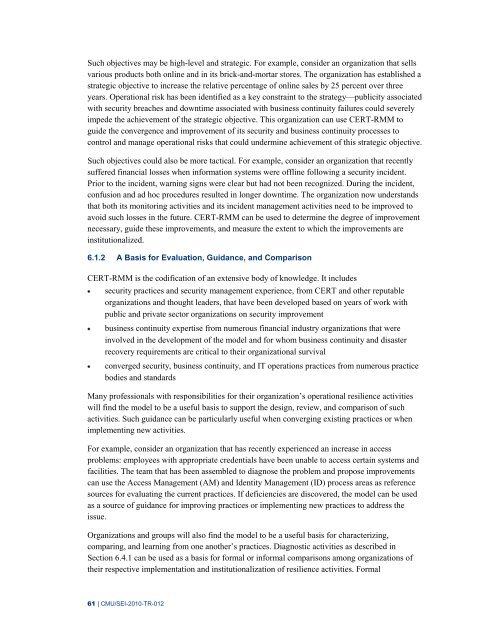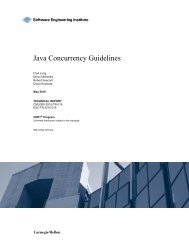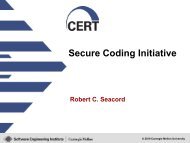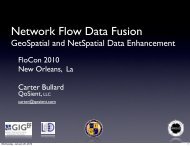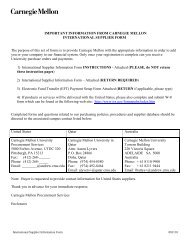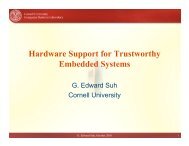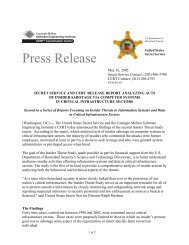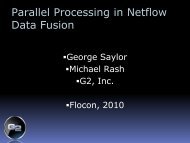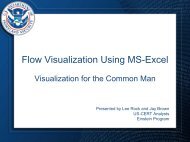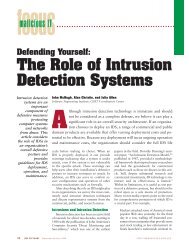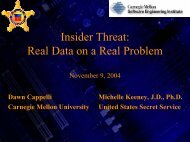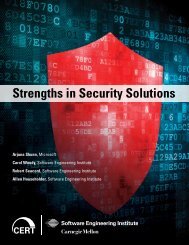CERT Resilience Management Model, Version 1.0
CERT Resilience Management Model, Version 1.0
CERT Resilience Management Model, Version 1.0
- No tags were found...
You also want an ePaper? Increase the reach of your titles
YUMPU automatically turns print PDFs into web optimized ePapers that Google loves.
Such objectives may be high-level and strategic. For example, consider an organization that sellsvarious products both online and in its brick-and-mortar stores. The organization has established astrategic objective to increase the relative percentage of online sales by 25 percent over threeyears. Operational risk has been identified as a key constraint to the strategy—publicity associatedwith security breaches and downtime associated with business continuity failures could severelyimpede the achievement of the strategic objective. This organization can use <strong>CERT</strong>-RMM toguide the convergence and improvement of its security and business continuity processes tocontrol and manage operational risks that could undermine achievement of this strategic objective.Such objectives could also be more tactical. For example, consider an organization that recentlysuffered financial losses when information systems were offline following a security incident.Prior to the incident, warning signs were clear but had not been recognized. During the incident,confusion and ad hoc procedures resulted in longer downtime. The organization now understandsthat both its monitoring activities and its incident management activities need to be improved toavoid such losses in the future. <strong>CERT</strong>-RMM can be used to determine the degree of improvementnecessary, guide these improvements, and measure the extent to which the improvements areinstitutionalized.6.1.2 A Basis for Evaluation, Guidance, and Comparison<strong>CERT</strong>-RMM is the codification of an extensive body of knowledge. It includessecurity practices and security management experience, from <strong>CERT</strong> and other reputableorganizations and thought leaders, that have been developed based on years of work withpublic and private sector organizations on security improvementbusiness continuity expertise from numerous financial industry organizations that wereinvolved in the development of the model and for whom business continuity and disasterrecovery requirements are critical to their organizational survivalconverged security, business continuity, and IT operations practices from numerous practicebodies and standardsMany professionals with responsibilities for their organization’s operational resilience activitieswill find the model to be a useful basis to support the design, review, and comparison of suchactivities. Such guidance can be particularly useful when converging existing practices or whenimplementing new activities.For example, consider an organization that has recently experienced an increase in accessproblems: employees with appropriate credentials have been unable to access certain systems andfacilities. The team that has been assembled to diagnose the problem and propose improvementscan use the Access <strong>Management</strong> (AM) and Identity <strong>Management</strong> (ID) process areas as referencesources for evaluating the current practices. If deficiencies are discovered, the model can be usedas a source of guidance for improving practices or implementing new practices to address theissue.Organizations and groups will also find the model to be a useful basis for characterizing,comparing, and learning from one another’s practices. Diagnostic activities as described inSection 6.4.1 can be used as a basis for formal or informal comparisons among organizations oftheir respective implementation and institutionalization of resilience activities. Formal61 | CMU/SEI-2010-TR-012


